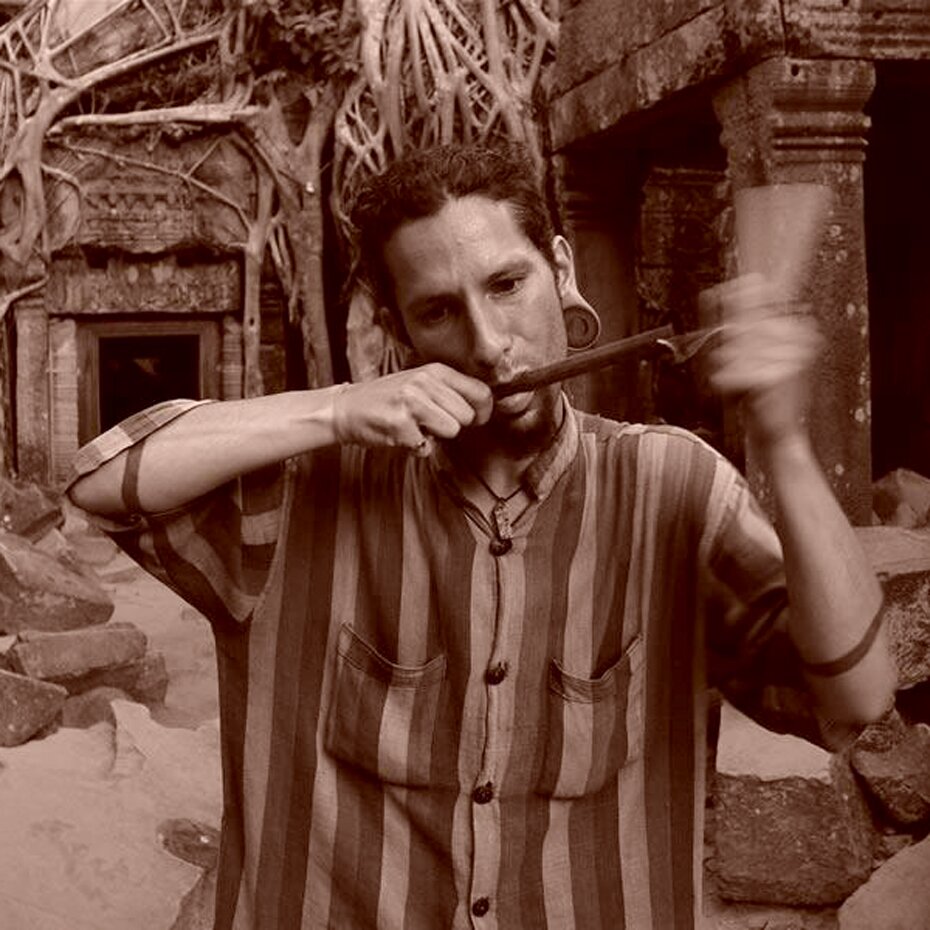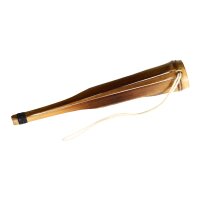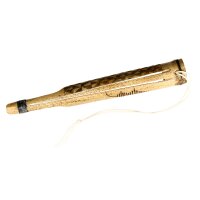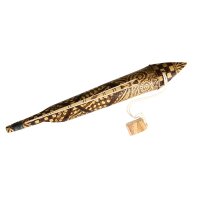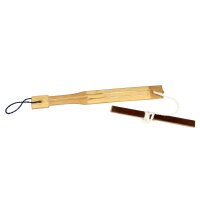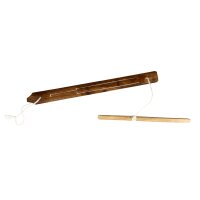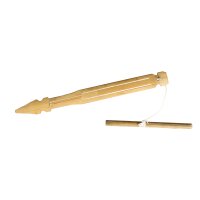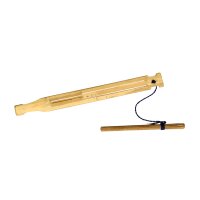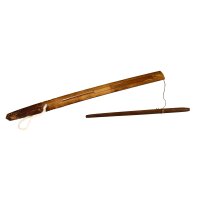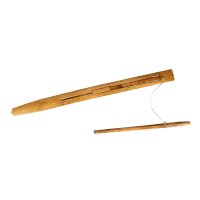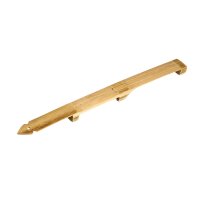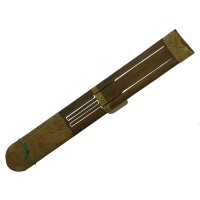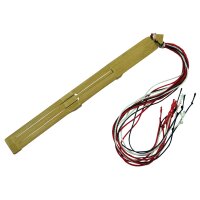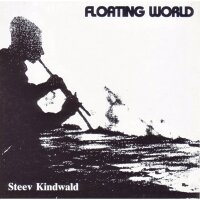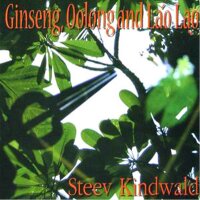Steev Kindwald unites diverse cultural influences as a musician and instrument maker like no one else. He absorbed a huge part of his playing technique on the double flute Alghoza and different mouth harps in Asia, mainly in India and Southeast Asia. He also takes his inspiration from old instruments, indeed very old instruments from museum collections or even archaeological excavations. Steev’s taste for complex, rhythmic structures roots back to his origins. A part of his family originates from Transylvania, Romania. Steev had a chat with Helen from Dan Moi about his encounters with instrument makers in Asia and furthermore about his approach to making bamboo mouth harps.
What is your style of playing Jaw Harp?
Mountain Flamenco Gong Trance Ceremony Carpathian Rishi Monk Jogi Carnatic Jazz!!! I have learned many traditional tunes, I mix a lot of different things together. I try to create elements within that, moving bass tones, very simple short patterns and mix them together in layers.
I do a lot of rhythmic play, a lot of asymmetric rhythms, that´s my great passion. Which may be my Transylvanian side, Carpathian mountains really, where there is a lot of these different rhythms, and then I hybridize it, because it´s fun to play in 15 or 9 or 27 or 13--4 as well! Each rhythm has a frequency and then you are playing with those different patterns.
Accented breath and control of the sound colour is what can make the Jaw Harp something fabulous! My goal is ever to push my limits and add yet another layer of sound to the Jaw Harps song.
When I play traditional tunes from the desert, the easiest ones are the pentatonic tunes, they are much more clear. When I play for traditional people, if they hear the tune, then it´s right. Always when I´m performing, I imagine I´m in front of a very traditional person. And when they are satisfied, then it´s good. That´s my litmus test of quality. In the sum total; one needs to go to the heart of the audience.
Which music inspired and shaped you?
Firstly, the sounds of nature are a constant inspiration since starting to play the Jaw Harp around age 12 -- 37 years ago. Playing while wandering the forests, rivers and lakes of my village.
I grew up in a culture of listening to epic classical western music plus hard bop jazz, going to bluegrass, jazz and blues festivals all the time. I was very fortunate, because there were also all these vinyl LPs of ethnic music at our local library in the village, from the time when there was no electricity in many areas where they were recorded. I was listening to music from Kashmir, Iran, Balinese and Javanese Gamelan, Morocco, India, records of gagaku orchestras of China, Korea, and Okinawa, Japan.
These old scratchy disks, of often poor quality recordings, are really amazing genuine performances; These were the references for me and continue to be -- 99 percent of the music made on this planet and in the human history is this natural human music.
I have passed the last 20 plus years almost constantly travelling for the music, mostly in Asia among tribal ethnicities, Sufis, nomads and Gypsy/Roma peoples. I have since studied with master players and makers from Nepal and Tibetan Himalaya to the Indian deserts to south India classical to mountain tribals in various parts of Southeast Asia to Genggong ensembles in central Indonesia.
My focus is not to merely reproduce traditions but to put this into my art to create original rooted hybrids that entrance!
Where did you learn to make Jaw Harp and with whom do you work with when making Jaw Harps?
Where I fell in love wandering in the desert ==== In the western region of Rajasthan I have been with two Morchang forging families since the last 20 years now. I see the older generation pass, the middle generation is still active and the younger generation may pick up the tradition.
They work with their hands constantly. There are no machines other then a light bulb occasionally when they work in the night. I assist, I learn from them, we collect the metals, we try to improve the quality, if their hands or their eyes are becoming damaged, it´s time to take a break. I often cook for them, we eat and drink together. We see the animals get sick, and we try to take care.
It´s kind of a whole life experience. Of cause they don´t just make jaw harps. They are basically nomads at heart. Most of the older generation, until the age 15 to 30, have travelled in donkey carts from village to village repairing tools and selling items they have made of metal. So they have great stories and are fascinating people;
Because they are considered low caste, they are dealing with all sorts of people who need their metal items. They are dealing with both high and low caste Hindus, with every variety of Muslim you can imagine, with Gypsy people, tribals, even foreigners!; so they are really between all the worlds, they are quite magical people, though that may be considered a cliché, its still true!
I have studied, researched and worked with makers in east Bali since 1999, different parts of Java, western India, Pakistan, Nepal, Burma, Thailand, Cambodia, Nepal and Japan. In the mountain in Lao PDR I visited and researched several families, where they make these incredibly detailed Jaw Harps from scrap war materials, which actually would be hard to make with a machine.

Even their tools are made by themselves! A lot of their handwork is so fine, you could not cut it with a laser! They have developed techniques that would be more advanced than most machines even today.
The gap on a high quality handmade Genggong of palm stem wood between the tongue and frame is around 0.2mm -- a Swiss watches acceptable degree of error is 0.3mm...
What is your approach to make Jaw Harps?
I prefer handwork. Occasionally I use a soldering iron to do detailed burning patterns and the rest is handwork and as little tools as possible, just like the masters and teachers work who I´ve been around over the years.
When I make instruments people often ask me, is this traditional or did you make it?, because we don´t know the difference anymore! That´s good, that keeps the roots. So I´m creating Jaw Harps based on traditions and hybrids as well, because that makes the tradition move forward.
My recent obsession is perfecting the double Genggong that plays 2 distinct tones in one instrument -- it does not really exist in traditions and that is exciting!
You had a box with dozens of Jaw Harps in, what instruments are you collecting in this „Magic Jaw Harp Box“?
There are different kinds of bamboo, palm stem and brass mouth harps, most of which I have made. A lot of them are string activated which is called Genggong in Malay-Indonesian where it´s most famous.
These are the instruments that really pulled my heart, so to speak, because they are very exciting. People love them as they produce a sound unimaginable and they are very pleasurably challenging to play.

In the box you see harps, that I collected in Java, Eastern Bali, most of the instruments I make are modelled from the museum collection in Berlin where I worked on the catalogue. They come from late 19th and early 20th century collections. I do accurate reproductions of these instruments and compare them with the living tradition mostly in places that I have travelled almost non stop the last 20 years seeking the perfect sound.
In my village as a child my first Jaw Harp was this snoopy harp which is rather low quality but very sturdy! In fact if you really push the instrument and you know how to play with the frame gap you start getting harmonics and vibrations that are strong.
When people learn on this difficult instruments, they become quite good, because they have to push the instrument. It´s often best to start on a difficult instrument for study to develop a sense of dynamics and strength.
From which instruments do you get your inspiration from to make your Jaw Harps?
When I make instrument it should be high quality. Once you know these traditional instruments you are more satisfied. I´m doing a lot of hybrids and reproducing Jaw Harps from Himalaya, Tibet, Borneo 19th century pieces, Sakhalin island. And Papua has metal jaw harp the recent years in the spirit of recycling metal. So the instruments I make are very stable, with a good quality sound and something that inspires people. The sounds people love and if they are willing to take time, they will learn them.
There are also instruments from India, Pakistan, China, Nepal, Lao PDR and Japan. I buy from these makers since many years and I often work with them directly when possible. I find people who work with their hands fascinating; They live with their world, with the things they make, they are often very connected. They have shared an enormous amount of knowledge with me and they have deeply influences me, it´s the time to create and work with very detailed decorations.
Working in metals, learning how to process the bamboo (that is a large world) and materials so that they are stable and solid. I collect most of the bamboo myself in Japan, Lao PDR, Burma, Nepal, Northern Thailand -- in Indonesia I collect a lot of palm stem in mountain forest gardens which is always an adventure!
Such material you cannot buy in a shop! A common technique in the past was make Jaw Harps and other tools from very hard and stable smoked bamboo from the roof of the house where there was a daily fire -- up to 200 years in some cases! So when I see a traditional old house being taken down its time to find bamboo!
Do you have any evidence for how old the Jaw Harp might be?
There are instruments from Papua New Guineawhich we would tap directly with our hand instead of pulling or striking it, and, they may be the oldest style considering they have an idioglottal reed rather than proto Jaw Harps.
To strike an instrument directly is more in the mind of a stone age person and those instruments can indeed be easily made with stone tools by cracking and shaving the bamboo. We know people have been living on Papua Island between 20.000 to 60.000 years at the least! One can imagine those instruments are at least 30.000 years old likely older, but of course bamboo does not last easily in the archaeological record.
What would this music have sounded like? Today some people say the mouth harp is an analog synthesizer and music must have sounded much more like todays modern music long time ago.
We don´t know, but when you live with these instruments and you play them all the time, not to study, but as a part of your life, you will discover a clear picture of what sounds these instruments can give.

Papua Island where the Jaw Harp is active since millenia, has the most concentrated number languages in the world, they have an enormous variety of languages because of the isolation of each valley and constant ritualistic warfare. A lot of Asian Jaw Harp music seems to be based on speech, for example Hmong music is communication, talking, riddles, poetry, love play, secret things that you can not express with your mouth. So you are dealing with a communication, natural sounds and effects on the mind and the body.
The phase filter sound processing harmonics along with arpeggios by using glottal stops method is what reminds people of an analog synthesizer which is essentially chips made of quartzite rich sand --- now that is something to consider...
How do you choose what to play in a concert?
Smell the air and proceed! Of course, I always have tunes pre-planned, but always it is best to finally let the mood set the music framework.
I love to request numbers from the audience to construct an improvised rhythm, challenging myself by giving a sound shape to a number. The point is to give them something that nourishes them and will be remembered in their dreams.
Would you mind playing a piece on one of your mouth harps for us?
This Jaw Harp, the lubuw (lubu), is from a Taiwanese tribal group and has 3 reeds. It is activated by snapping the string and angling the frame to play the correct reed while covering the other reeds so they do not resonate and this gives a clear sound --- however, sometimes there are other reeds resonating while I change reed and that give a special colour.
Many of the tribal groups of Taiwan have these instruments, it is well know among for Ami and Atayal people among other tribes in Taiwan. While the frame is made of bamboo, the tongues are made from metal. Traditionally these were hammered out of belt buckles from colonial people, because what other source of metal would such people have in earlier times?
The image of Taiwan today and tribal Taiwan is very different. Tribal Taiwanese would have been tattooed people doing extraordinarily complicated weaving, wearing colorful patterned clothing and having an incredible variety of instruments, very delicate instruments which are quite complicated to play.
When you play all these different instruments, you must play with a certain frame of mind, a certain consciousness. For example, when you spend many years playing 3 or more reeded jaw harps you potentially will also play with your mental state.
You are working with different mental states. So if you work with your hands for many years, your hands become very active and fluid. So when you are playing these instruments you end up feeling ideas of how these people perhaps lived or how we could live. You are receiving intangible information essentially ---- and when you play it, you are resonating intangible information.
